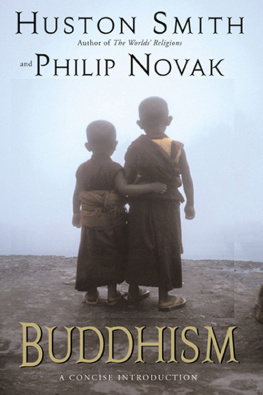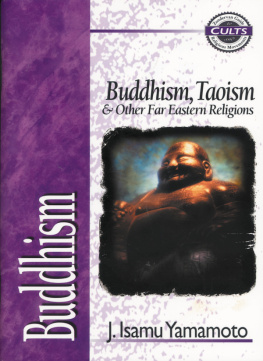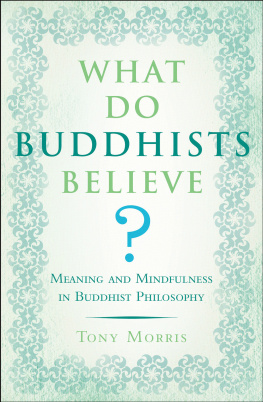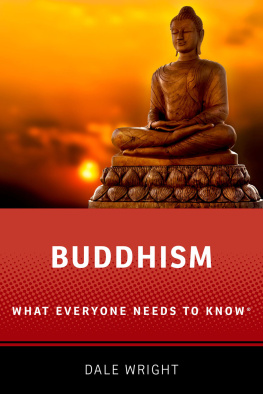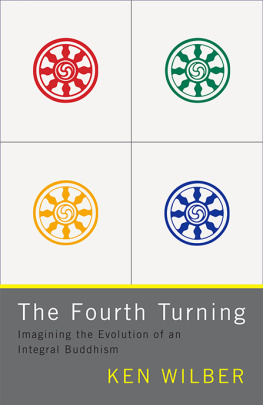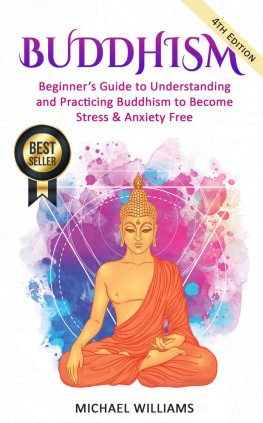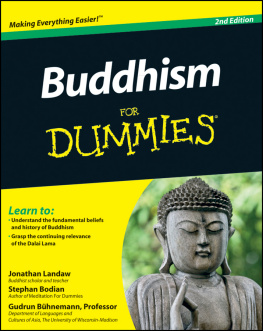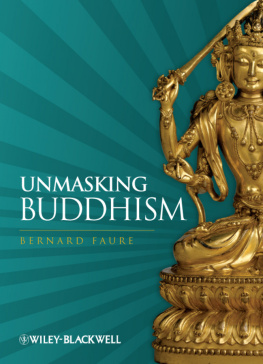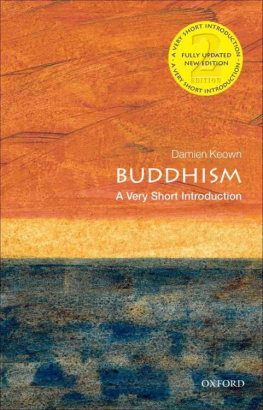The World's Religions: Our Great Wisdom Traditions
Why Religion Matters: The Fate of the Human Spirit in an Age of Disbelief
Buddhism: A Concise Introduction
The Soul of Christianity: Restoring the Great Tradition
Islam: A Concise Introduction
Tales of Wonder
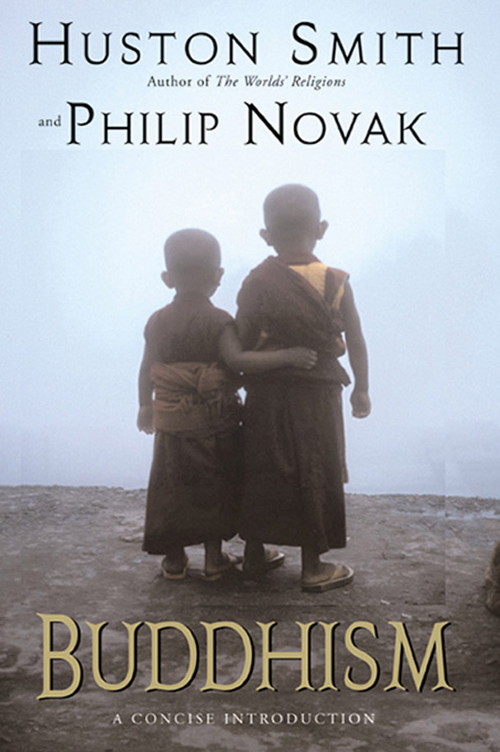
B UDDHISM
A CONCISE INTRODUCTION

HUSTON SMITH
AND PHILIP NOVAK

To all followers of the Dharma, and to others who are
interested in exploring its potentials to improve
individual lives and the course of history, the authors
respectfully dedicate this book.
CONTENTS
The Man Who Woke Up
The Silent Sage
The Rebel Saint
The Four Noble Truths
The Eightfold Path
Other Core Buddhist Concepts:
Nirvana, Anatta, the Three Marks of Existence, Dependent Arising, and Emptiness
Theravada and Mahayana:
The Great Divide
Vipassana:
The Theravadin Way of Insight
Zen Buddhism:
The Secret of the Flower
Tibetan Buddhism:
The Diamond Thunderbolt
The Image of the Crossing
The Confluence of Buddhism and Hinduism in India
The New Migration
America the Buddha Full
Adaptations:
The New Buddhism
America Starts Meditating I:
The Ways of Zen
America Starts Meditating II:
Tibetan Buddhism in Exile
America Starts Meditating III:
The Vipassana Movement
The Flowering of Faith:
Buddhisms Pure Land Tradition
An Annotated Guide

This book reconceives the chapter on Buddhism from Huston Smiths The Worlds Religions and takes advantage of the additional space a book provides to go deeper into Buddhisms basics. Most important here, Theravada Buddhism (which was overshadowed by Mahayana when The Worlds Religions was written) is brought closer to getting its due. Then, on these foundations the book erects a second story, so to speak. The second half of the book, entirely new, tells the story of Buddhisms migration to the West, particularly to America.
In this happily co-authored book, the authors have worked over every page together with Smith taking the lead in its first half and Novak in its second. Then, for reasons that will be noted in due course, the lead swings back to Smith who wrote the Afterword on Pure Land Buddhism.
The partnership that went into the book proved to be a fortunate one in many ways. Apart from the fact that the talents of each author complement those of the other, Novak wrote his doctoral dissertation under Smith at Syracuse University, and geographical proximityNovak teaches at Dominican University in San Rafael, a half-hours drive across San Francisco Bay from Smith in Berkeleyhas allowed their friendship to age like old wine. One proof of its vintage is that they felt comfortable in raising their voices at each other when disputes arose as they invariably must in joint authorship. In every case, however, the differences were resolved in ways that both parties felt led to a better book.
Yet another way the authors complement each other is that between them their Buddhist practices cover both sides of Buddhism. Novak has been a lifelong practitioner of Theravada vipassana, while Smith was for fifteen years a disciple of Goto Zuigan Roshi in Mahayana Zen.
The authors wish to thank the books editor, John Loudon, for conceiving and commissioning this book. The inducement it provided for them to clear eight months to wash their minds and spirits once again through the treasures of this great tradition came as a great refreshment, staking out as it were an oasis in their busy lives. Long, long ago the Buddha embarked on a search for a way to live life fully and vibrantly while facing unflinchingly the inexorable axioms of aging, sickness, and death. By the time of his death he had found such a way, and in the 2,500 years since, it has transformed the lives of the millions who have followed him.
Two other notes need to be added. The first concerns terminology. Buddhist vocabulary has come down to us in two ancient Indian languages, Pali and Sanskrit, and Sanskrit terms like karma, nirvana, and dharma are more familiar in the West than their Pali versions, kamma, nibbana, and dhamma . One might conclude that exclusive use of Sanskrit terms in a book like this would be the obvious way to proceed. But the matter is trickier. Sometimes the reverse is true and Pali terms like anicca (impermanence) and anatta (no-self) are better known than the Sanskrit anitya and anatman . Accordingly, our general rule has been to honor familiar usage rather than attempt to maintain consistency with one language. Exceptions to this rule occur only in Chapters 8 and 18, both on Theravada Buddhism, where out of deference to that traditions close connection to Pali we use only Pali terms. Second, with the exception of terms like karma and nirvana, which have become part of the Wests vocabulary, we italicize foreign terms the first time we use them but not thereafter.
It remains for us to acknowledge the invaluable aid we have received from others. A certain writer has said that everybody except myself has been my mentor and we resonate with that assertion. However, there are certain individuals who have been special sources of help and encouragement in this project. We would like to thank Dhananjay Chavan, John Kling, Donald Rothberg, Harry and Vivian Snyder, and Roger Walsh for their valuable suggestions upon reading parts or all of the text during various phases of its completion. Great thanks is also due to our production editor, Chris Hafner, for superb supervision. Tetsuo Unnos help with the books Afterword will be acknowledged there. Of course, any defects that remain in the text are solely the authors responsibility. Finally, Novak would like to thank Dominican University of California for the sabbatical leave that freed him to work on this project.
Huston Smith and Philip Novak
November 2002

Acknowledgment is made to the following for permission to reprint copyrighted material:
From Buddhist Texts Through the Ages, Muriel Conze, 1995. Reproduced with permission of Oneworld Publications.
From Buddhist Scriptures, translated by Edward Conze (Penguin Classics, 1959), Edward Conze, 1959. Reproduced with permission of Penguin Books, Ltd.
From Buddhism: Its Essence and Development by Edward Conze (Birmingham, England: Windhorse Publications, 2001), Janet Kavanaugh, with permission from Windhorse Publications.
From The Awakening of the West: The Encounter of Buddhism and Western Culture (1994) by Stephen Batchelor with permission of Parallax Press, Berkeley, California, www.parallax.org
From Like a Dream, Like a Fantasythe Zen Writings of Nyogen Sensaki , used with permission from The Zen Studies Society, 223 East 67th St., New York, NY 10021. Eido T. Shimano, Roshi, Abbot. www.zenstudies.org
From The New Buddhism by James William Coleman, 2001 by James William Coleman. Used with permission of Oxford University Press, Inc.
From Nyanaponika Thera, trans., Anguttara Nikaya: An Anthology, part II in The Wheel, Nos. 20811, 56 ff; The Practice of Metta in the Sutta Nipata 14551, translated by Nanamoli Thera in The Wheel, no. 7, p. 19; Majjhima Nikaya , Sutta no. 7, The Simile of the Cloth, translated by Nyanaponika Thera; Digha Nikaya 16 (Mahaparinibbana Sutta), Part 3, verse 61; Soma Thera, trans., The Way of Mindfulness, 6th revised ed., a translation of the Sattipatthana Sutta of the Majjhima Nikaya, p. 11 of online version, http://www.accesstoinsight.org. CourtesyBuddhist Publication Society, Inc., Sri Lanka.
Next page
